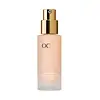What's inside
What's inside
 Key Ingredients
Key Ingredients

 Benefits
Benefits

 Concerns
Concerns

 Ingredients Side-by-side
Ingredients Side-by-side

Water
Skin ConditioningCyclopentasiloxane
EmollientTrimethylsiloxysilicate
EmollientPEG/PPG-18/18 Dimethicone
EmulsifyingButylene Glycol
HumectantTribehenin
EmollientPolyglyceryl-3 Diisostearate
EmulsifyingMagnesium Sulfate
Tocopheryl Acetate
AntioxidantPolymethylsilsesquioxane
Methicone
EmollientLaureth-7
EmulsifyingXanthan Gum
EmulsifyingAlumina
AbrasiveSodium Dehydroacetate
PreservativeDisteardimonium Hectorite
StabilisingCellulose Gum
Emulsion StabilisingPropylene Carbonate
SolventPentaerythrityl Tetra-Di-T-Butyl Hydroxyhydrocinnamate
AntioxidantPhenoxyethanol
PreservativeIron Oxides
Mica
Cosmetic ColorantCI 77891
Cosmetic ColorantWater, Cyclopentasiloxane, Trimethylsiloxysilicate, PEG/PPG-18/18 Dimethicone, Butylene Glycol, Tribehenin, Polyglyceryl-3 Diisostearate, Magnesium Sulfate, Tocopheryl Acetate, Polymethylsilsesquioxane, Methicone, Laureth-7, Xanthan Gum, Alumina, Sodium Dehydroacetate, Disteardimonium Hectorite, Cellulose Gum, Propylene Carbonate, Pentaerythrityl Tetra-Di-T-Butyl Hydroxyhydrocinnamate, Phenoxyethanol, Iron Oxides, Mica, CI 77891
Aloe Barbadensis Leaf Juice
Skin ConditioningEthyl Palmate
EmollientGlycerin
HumectantPolyglyceryl-4 Diisostearate/Polyhydroxystearate/Sebacate
EmulsifyingSimmondsia Chinensis Seed Oil
EmollientPropanediol
SolventBellis Perennis Flower Extract
Skin ConditioningPolyglyceryl-3 Diisostearate
EmulsifyingMicrocrystalline Cellulose
AbsorbentCopaifera Officinalis Resin
MaskingCoco-Caprylate/Caprate
EmollientMagnesium Sulfate
Glyceryl Oleate
EmollientPolyglyceryl-2 Dipolyhydroxystearate
Skin ConditioningTrihydroxystearin
Skin ConditioningTriheptanoin
Skin ConditioningCaprylyl Glyceryl Ether
CleansingPhysalis Pubescens Fruit Juice
Skin ConditioningTetrahexyldecyl Ascorbate
AntioxidantPhenylpropanol
MaskingCaprylic/Capric Triglyceride
MaskingXanthan Gum
EmulsifyingC9-12 Alkane
SolventDilinoleic Acid/Butanediol Copolymer
Hydrogenated Castor Oil/Dimer Dilinoleic Acid Copolymer
Carapa Guaianensis Seed Oil
Skin ConditioningRaspberry Ketone
MaskingEuterpe Oleracea Fruit Oil
Skin ConditioningCaprylhydroxamic Acid
Hydrogenated Lecithin
EmulsifyingAloe Barbadensis Leaf Juice Powder
Skin ConditioningCellulose
AbsorbentRosmarinus Officinalis Leaf Extract
AntimicrobialArginine
MaskingPhenethyl Alcohol
MaskingCastor Oil/Ipdi Copolymer
Magnesium Chloride
Mica
Cosmetic ColorantTocopherol
AntioxidantSodium Chloride
MaskingPotassium Chloride
Potassium Phosphate
BufferingDisodium Phosphate
BufferingLecithin
EmollientAscorbyl Palmitate
AntioxidantHydrogenated Palm Glycerides Citrate
EmollientCalcium Chloride
AstringentCI 77891
Cosmetic ColorantCI 77491
Cosmetic ColorantCI 77492
Cosmetic ColorantCI 77499
Cosmetic ColorantAloe Barbadensis Leaf Juice, Ethyl Palmate, Glycerin, Polyglyceryl-4 Diisostearate/Polyhydroxystearate/Sebacate, Simmondsia Chinensis Seed Oil, Propanediol, Bellis Perennis Flower Extract, Polyglyceryl-3 Diisostearate, Microcrystalline Cellulose, Copaifera Officinalis Resin, Coco-Caprylate/Caprate, Magnesium Sulfate, Glyceryl Oleate, Polyglyceryl-2 Dipolyhydroxystearate, Trihydroxystearin, Triheptanoin, Caprylyl Glyceryl Ether, Physalis Pubescens Fruit Juice, Tetrahexyldecyl Ascorbate, Phenylpropanol, Caprylic/Capric Triglyceride, Xanthan Gum, C9-12 Alkane, Dilinoleic Acid/Butanediol Copolymer, Hydrogenated Castor Oil/Dimer Dilinoleic Acid Copolymer, Carapa Guaianensis Seed Oil, Raspberry Ketone, Euterpe Oleracea Fruit Oil, Caprylhydroxamic Acid, Hydrogenated Lecithin, Aloe Barbadensis Leaf Juice Powder, Cellulose, Rosmarinus Officinalis Leaf Extract, Arginine, Phenethyl Alcohol, Castor Oil/Ipdi Copolymer, Magnesium Chloride, Mica, Tocopherol, Sodium Chloride, Potassium Chloride, Potassium Phosphate, Disodium Phosphate, Lecithin, Ascorbyl Palmitate, Hydrogenated Palm Glycerides Citrate, Calcium Chloride, CI 77891, CI 77491, CI 77492, CI 77499
 Reviews
Reviews

Alternatives
Ingredients Explained
These ingredients are found in both products.
Ingredients higher up in an ingredient list are typically present in a larger amount.
Ci 77891 is a white pigment from Titanium dioxide. It is naturally found in minerals such as rutile and ilmenite.
It's main function is to add a white color to cosmetics. It can also be mixed with other colors to create different shades.
Ci 77891 is commonly found in sunscreens due to its ability to block UV rays.
Learn more about CI 77891Magnesium Sulfate is a salt. More specifically, it is an epsom salt, or the bath salt used to help relieve muscle aches.
Despite having ‘sulfate’ in the name, it isn’t a surfactant or cleansing agent like sodium lauryl sulfate. Unlike those sulfates, magnesium sulfate doesn’t have the same cleansing or foaming properties (it's simply a type of salt).
In cosmetics, Magnesium Sulfate is used to thicken a product or help dilute other solids. It is a non-reactive and non-irritating ingredient.
One study shows magnesium deficiency may lead to inflammation of the skin. Applying magnesium topically may help reduce inflammation.
You can find this ingredient in sea water or mineral deposits.
Learn more about Magnesium SulfateMica is a naturally occurring mineral used to add shimmer and color in cosmetics. It can also help improve the texture of a product or give it an opaque, white/silver color.
Serecite is the name for very fine but ragged grains of mica.
This ingredient is often coated with metal oxides like titanium dioxide. Trace amounts of heavy metals may be found in mica, but these metals are not harmful in our personal products.
Mica has been used since prehistoric times throughout the world. Ancient Egyptian, Indian, Greek, Roman, Aztec, and Chinese civilizations have used mica.
Learn more about MicaPolyglyceryl-3 Diisostearate is an emulsifer and emollient. It comes from Isostearic Acid and Polyglycerin-3.
As an emulsifier, it helps stabilize products by preventing oils and water from separating.
This ingredient may not be Malassezia folliculitis, or fungal acne safe.
Learn more about Polyglyceryl-3 DiisostearateXanthan gum is used as a stabilizer and thickener within cosmetic products. It helps give products a sticky, thick feeling - preventing them from being too runny.
On the technical side of things, xanthan gum is a polysaccharide - a combination consisting of multiple sugar molecules bonded together.
Xanthan gum is a pretty common and great ingredient. It is a natural, non-toxic, non-irritating ingredient that is also commonly used in food products.
Learn more about Xanthan Gum